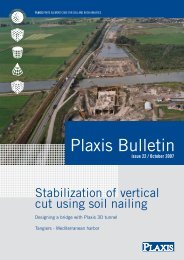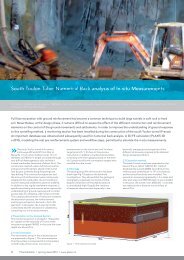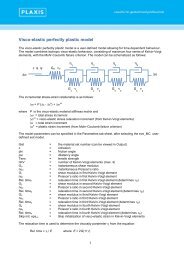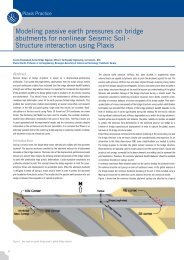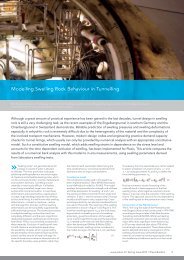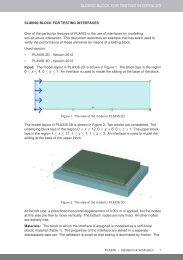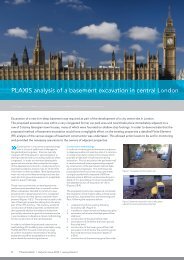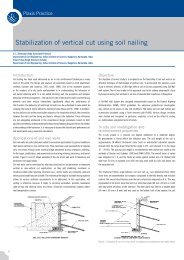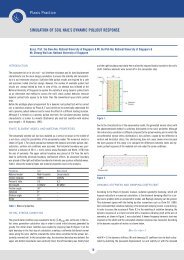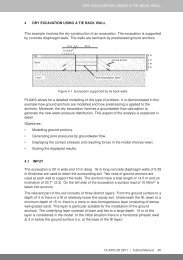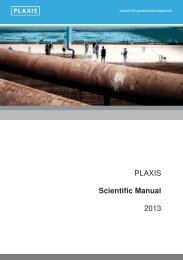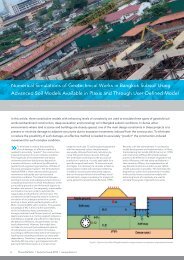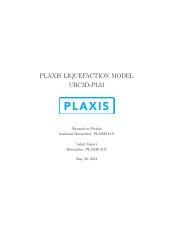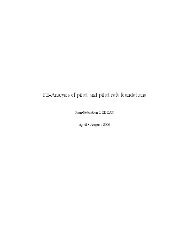Iss31 Art3 - Numerical Analysis of Piled Embankments ... - Plaxis
Iss31 Art3 - Numerical Analysis of Piled Embankments ... - Plaxis
Iss31 Art3 - Numerical Analysis of Piled Embankments ... - Plaxis
You also want an ePaper? Increase the reach of your titles
YUMPU automatically turns print PDFs into web optimized ePapers that Google loves.
part C is carried by the s<strong>of</strong>t subsoil. The load parts<br />
are vertical loads and are given in kN/pile.<br />
Scale tests<br />
A section <strong>of</strong> an embankment is modelled in a<br />
metal box <strong>of</strong> 1.1 x 1.1 x 1 m 3 . Four piles are situated<br />
on the bottom <strong>of</strong> the box. The s<strong>of</strong>t subsoil<br />
between the piles is modelled with a watertight<br />
foam cushion filled with water. A tap allows<br />
drainage from the foam cushion during the test,<br />
which models the consolidation process <strong>of</strong> the s<strong>of</strong>t<br />
subsoil. The GR is attached to a steel frame and<br />
situated on top <strong>of</strong> the foam cushion with a sand<br />
layer <strong>of</strong> ca. 2 cm in between. On top <strong>of</strong> the GR, an<br />
embankment <strong>of</strong> 0.42 m is constructed <strong>of</strong> granular<br />
material (crushed rubble). The top load on the<br />
embankment is applied with a water cushion. This<br />
provides an equally distributed top load. The<br />
metal box is closed by a cover and tie rods. A side<br />
and top view <strong>of</strong> the scale test set-up is given in<br />
figure 2.<br />
The scale tests are performed in several steps<br />
<strong>of</strong> consolidation by draining the foam cushion<br />
and increasing top load. The load steps and<br />
consolidation steps alternate: each top load step<br />
is followed by ca. 3 consolidation steps. At the end<br />
<strong>of</strong> the scale test, vacuum pressure is applied to the<br />
foam cushion. This reduces the subsoil support<br />
to zero. After every drainage or top load step, the<br />
system is allowed to stabilise for several hours.<br />
The load distribution is measured with pressure<br />
cells. Pressure cells are placed on top <strong>of</strong> piles, one<br />
above and one underneath the GR. The pressure<br />
cell above the GR measures load part A and the<br />
pressure cell underneath the GR measures load<br />
parts A+B. Load part B is calculated by subtracting<br />
load part A from load parts A+B. Additionally, the<br />
pressure in the foam cushion is measured, which<br />
gives load part C. The top load is measured with<br />
a water pressure meter in the water cushion. The<br />
vertical deformation <strong>of</strong> the GR is measured on<br />
three locations with a liquid levelling system. The<br />
locations <strong>of</strong> the measurements are given in figure<br />
2.<br />
Figure 2: Side view and top view <strong>of</strong> scale test set-up<br />
www.plaxis.nl l Spring issue 2012 l <strong>Plaxis</strong> Bulletin 13



